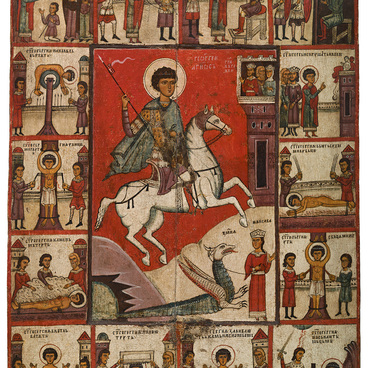Archangel Gabriel is the oldest icon in the Russian Museum collection. Created by an unknown author in the 12th century it is one of the brightest artworks of the pre-Mongol period. As most of researchers presume, it belongs to the Novgorod school of painting.
Archangel Gabriel
Creation period
XII century
Dimensions
49x38,8 cm
Technique
Wood, levkas, tempera
Collection
Exhibition
50
Open in app#3
Unknown Author
Archangel Gabriel
#2
#4
Novgorod served as a focal point of Russian art and culture in the Middle Ages. Since the city was not affected by the destructive force of the Tatar-Mongol yoke in the 13th — 15th centuries, it has preserved a rich cultural heritage of ancient masters to the present day.
According to Christian tradition, Gabriel comes to earth to proclaim God’s purpose to people. It was he who brought the Virgin Mary the good news of the birth of a Son, he also informed her of an imminent death. Like the archangel Michael, Gabriel is considered an archistratigue, i.e. one of the main angels in the heavenly army.
#11
Icon painters usually depicted Gabriel life-size, in full regalia and with his inherent attributes: a blossoming branch of a tree, a lily, a mirror or a candle. Therefore, this image with a large angel’s face is very rare for his iconography.
Archangel Gabriel. State Russian Museum.
#6
Another unique feature is that the hair of the angel is made in the assist technique: an unknown master laid a thin thread of gold leaf through each hair. Hence, the second name of the image is Golden Hair Angel. In icon painting folds of clothes, wings of angels, and even other objects also could be emphasized in gold.
#8
The golden shine of hair symbolized greatness, immortality and the divine spark in ancient art. The image is generally close to Byzantium traditions, which originate from Hellenistic art. This connection is proven by the large eyes of the saint with an eastern shape of eyes, a Greek type of face: a thin nose, lack of a bridge of nose, a rounded chin.
#7
The icon was probably part of the altar barrier (which is a wall between the altar and the main part of the temple) and was part of the Deesis row. The Deesis, from the Greek supplication, is a composition of three, five, seven or more images.
Christ was usually depicted in the center of the Deesis and around him — the Mother of God, John the Baptist, the apostles and saints who pray for the sins of people. The image of the archangel Gabriel was most often placed to the left of Jesus.
#9
It was customary in the Middle Ages to renew paintings, and not to restore. The icon was always covered with a protective layer: drying oil and varnish. After 30-90 years, the varnish completely darkened, and the next generation of icon painters created a new image directly on top of the previous one. Usually they kept the plot, but could change the style and aesthetics reflection of the spirit of their time.
#10
The Archangel Gabriel was discovered in the first half of the 1920s in the Antiquities Department of the Rumyantsev Museum in Moscow. In 1925, the icon was restored, but due to poor preservation, the restoration artist was unable to clear the entire author’s layer. Therefore, a significant part of the image that we see dates back to the 17th century: a green background, a part of clothes and hair.
#12
State Russian Museum
read morehide
00:00
00:00
1x
Archangel Gabriel
Creation period
XII century
Dimensions
49x38,8 cm
Technique
Wood, levkas, tempera
Collection
Exhibition
50
Open in app
Share



